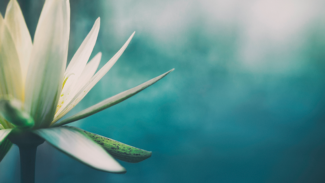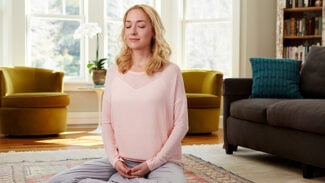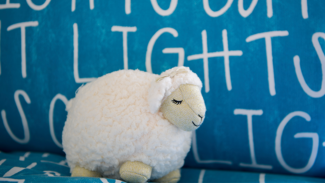Hiya Wise One,
At the start of the New Year I asked my husband, Brian if he would like to try meditating with me. Usually this request gets a huge eyeroll, followed by a casual “maybe” which means “nope”. But after we created the Self-Care for Busy People meditation album together he found a new love for this regenerative practice. Rather than listening to my voice though, (he gets to hear it whether he likes it or not LOL!) I suggested we try using the Headspace app together.
The results of meditating regularly are measurable and truly life-enhancing and today I have a powerful two-fer for ya! A free meditation from my album and an incredible interview with Andy Puddicombe, the founder of Headspace. This practice has benefited me deeply for over a decade and I know it can improve your mental and physical well-being too (if it hasn’t already!).
So let’s jump right in with Andy and get the 411 on meditation.
In his early twenties, Andy Puddicombe decided to leave college and become a Buddhist monk. And for more than ten years, his meditation training and adventures took him all over the world. In 2004, Andy returned to the UK without his monk’s robes. He had one simple aim: to demystify meditation and make it accessible, relevant and beneficial to the masses. Andy did just that (Bravo!). With that epic goal in mind, Headspace was born in 2010. I’m so happy to be interviewing Andy for you all today, I think you’ll adore this guy as much as I do.
Kris: Welcome Andy! Let’s cover the basics for those who are new to this practice. What is meditation and why should we do it?
Andy: Meditation itself is about letting go of any need to try and get somewhere or achieve something. So if we are approaching it in the right way, there is no pressure whatsoever. In fact, it may be the very first thing we have ever done in our entire life where there is no goal or result intended.
In essence though, meditation provides a framework in which we are able to step back from habitual thinking and emotions, so that we can witness them with clarity and perspective. When we learn to do this, the mind begins to calm down, as does the body. In turn we experience more quiet and a greater sense of ease in every area of life. It is a remarkable shift in perspective, which really needs to be experienced, rather than explained. The Headspace Take10 program is a good place to start, as it’s just 10 minutes a day and the app is free to download too.
Kris: My husband Brian and I love the Headspace app and use it all the time. So how long should we sit for and what if we don’t like sitting? Are there other ways?
Andy: It’s best to approach meditation like anything else in life: start small, build up slowly and find your own personal sweet spot. For some people, this sweet spot is 10 minutes and for others it’s 60 minutes. To begin with, the most important thing is finding a time length which feels achievable and keeps us feeling motivated. Recent findings suggest that frequency rather than duration is more beneficial. So 10 minutes every day of the week is likely to be more constructive than 70 minutes on one day of the week.
For those people who hate sitting still or are always on the go, walking meditations are a great way to introduce mindfulness into your routine and have been practiced as a meditative technique for thousands of years. In everyday life, walking is usually an established and habituated action that requires very little concentration. The additional benefits from walking meditations include the process of connecting with nature which can help lift your mood and reduce feelings of stress and tension!
Kris: How will our lives change or shift if we commit to a regular practice?
Andy: 10 minutes a day over a sustained period can have a huge impact. It can help to reduce feelings of stress and anxiety, improve your sleep, enhance productivity at work, improve your physical performance in sports and even help to soften the edges in relationships as we become more patient, better listeners, and perhaps a little kinder too.
I think it gives everybody something different but generally speaking, it provides a greater sense of calm, clarity and perspective. Of course it can be used in many different ways, and these days you’re just as likely to find an Olympic athlete using it to improve their performance as you are global organisations using it to improve employee well-being. But perhaps the most important thing of all is that it allows us to connect with those around us, in a way that enriches our lives.
Kris: It can be challenging to create and stick to a new habit, even when it’s healthy for us. Do you have any tips for maintaining a regular practice?
Andy: Just think: same time, same place. Don’t judge yourself. If you miss a session, don’t use that as an excuse to miss another.

Kris: What benefits have you personally experienced from your meditation practice?
Andy: I think it has changed my perspective on the world around me, and the way I understand the mind. The biggest thing I got from it was the focus on being kind—it’s not something that’s often talked about in relation to meditation, and sounds almost clichéd, but as long as we have conflict in our own minds, and as long as we have conflict with others, we will never have peace of mind. It sounds obvious, but it wasn’t something I had ever considered, before going into the monastery.
I take some time each day to look after the health of my mind, to meditate; I have a greater appreciation for this precious human life and remember to be grateful daily; I spend more time thinking about the happiness of others and less time thinking about myself. Ironically, this makes me happy too!









Hello Kris!
Love all the work you do! I love the Headspace app too! I use it frequently on my commute (I use the bus)!
I frequently find myself daydreaming when I meditate. I try to keep focus- but when I keep a strong focus on something I find myself too wrapped up but when I “free my mind” I then find myself daydreaming…Any tips?
I’m with Andy on the tip he offered: “If you notice your mind wandering just gently bring your mind back to the counting,” “gently” being the operative word. Especially for someone new to meditation and even for those having done it for years, it’s the mind’s natural tendency to start to daydream or think or get busy. Another technique I’ve used when my mind starts drifting is to 1) turn them into clouds and let them float away in the air, or 2) turn them into leaves floating down onto the surface of a stream, and, likewise, let them flow past and away, and lastly, 3) turn them into little monkeys jumping and swinging from branch to branch above — a la “monkey mind — and let them jump into a lovely little rowboat on the previously mentioned stream, again letting them just be floated away on the “screen,” out of sight, and then back to breath and no images other than colors. Those techniques are helpful for me in my meditation. It’s very natural for the mind to wander. Hope that helps! Happy meditating!
The counting is okay- but as noted- when you’re still counting your mind is focused on the counting, no matter how gently it is done.
And the other technique you mentioned I’ve tried as well- turning them into clouds and letting them float away- I do that at the beginning of my meditation to “clear the field” .
For me its after that counting- after that initial clearing the field and find my mind “blank” I find myself daydreaming.
Anyways, thanks for the tips!
Love your tips. 🙂 kc
I love your meditation album! Before purchasing it I would meditate a couple times a week, but now I meditate with your morning and evening meditations every day and use one of the others in the middle of the day. If I am on the go I use an app. There’s a big difference to the quality of my day now I am doing it more regularly, I agree with Andy, being consistent is better than taking one big chunk of time out to do it once a week.
That is why your album is so good, lots of different ones and none take too long so in the end I meditate more than before ? love it!
Thank you so much for sharing, Anja! I’m thrilled. Keep it up! xo
Thank you Kris, your blog reminded me that I was supposed to receive your Meditation album as a bonus when I pre-ordered your Crazy Sexy Juice book but I never received it. 🙁
Hiya Miaiya: Email my team and we’ll take care of that ASAP! [email protected] xo, kc
Hi Kris,
I love meditation. About 10 years ago I learned how to meditate from Deepak Chopra at the Chopra Center in California. Over the years I have learned that even if my mind wanders I don’t judge myself, I come back to my mantra and continue on. This one thing has helped me let go of judging myself in other areas of my life. Meditation has taught me to be kinder to myself. My inner being never judges me. When I meditate I connect to my inner being, it feel so good. Thank you Kris for inspiring others to meditate.
I primarily use guided meditation for healing by Martin Rossman, but others too and I have the Headspace app and I am on day 4. I love Andy’s voice. I have found meditation but specifically the guided meditation for healing to be so powerful and helpful to calm my mind…escape my mind and my worries for some time and that has been life changing. I am a junky now. I can’t rave enough about it to anyone who will listen. I would love to go on a week long or month long meditation retreat. How relaxing does that sound? Thanks for sharing.
Thank you for the tip on Martin Rossman’s guided meditations. I remembered how much I liked him on a Andrew Weil meditation CD I used to listen to often. I went to YouTube and just did one and it does work very well. “Picture a quality you want more of (peace, joy, courage) and then grow it larger and larger until you feel it inside of you. Then picture a stiuation where you want to express that quality and see if you can bring it into alignment .” Powerful!
Great article! I like the message on kindness as well. I am a huge believer in the benefits of meditation and have struggled being consistent with it. I bought a Muse headband and that helps tremendously. I’m still ‘hit or miss’, but I’m gentle with myself and start again.
Hi Kris: I wanted to thank you from the bottom of my heart for your meditation album. I have suffered from severe insomnia for decades. I was recently informed that the medication I’ve been taking causes cognitive delay. When I went off it I spent literally weeks without sleeping more than 3 hours a night, completely unable to function at my job. Then I ran across your album and bought it. Miraculously I am able to fall asleep listening to it, and sleep the whole night. It is LIFE CHANGING. Thank you so much!!!
Great interview it was fun to hear from Andy because the headspace app is what introduced me to meditation and it is easy to share with friends and family. It’s awesome because his approach in the app is so calculated and peaceful amazing starting place. Now i sit in the morning with calm sounds for anywhere from 5-20 minutes just letting myself prepare for the day with a calmness and patience.
Thanks
For those who have been slightly confused or lost on how to do meditation, here’s a helpful article just for you.
In today life everyone is busy in work. People don’t think about their health. You are doing great work by sharing these easy methods of relaxation with us.
If you realize that it is hard for you to fall asleep, it is because you think too much, or you get easily distracted, as you saw in the previous points, meditation reduces all these symptoms or characteristics of thinking too much. So without a doubt it will help you fall asleep much faster.
I found useful steps for people who start meditating. I will follow these steps. Thanks a lot to Andy and Kris.